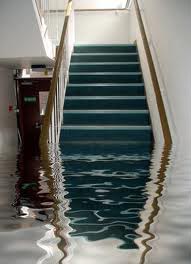|
|
HOME > TOM'S TIPS > When a Sump Pump Isn't Your Best BetRising exterior floodwaters create inward pressure against the walls of the building. A rapid rise or drawdown may create enough elevation difference between the interior and exterior water surfaces to damage a building’s walls or foundation.
However, a problem sometimes is encountered when the rapid drawdown of basement water occurs due to mechanical means following a flood. Well-meaning efforts to empty flooded basements with high capacity pumps can actually cause the lateral pressures of saturated soil to exceed the structural capacity of basement walls. The result? An inward collapse of the basement wall itself. The presence of water inside the basement walls, countering against the exterior lateral pressure, may actually help protect the wall’s structural integrity. My advice during a severe flooding situation is this: turn OFF the sump pump, move your furniture and other possessions to higher ground and wait. Wait for the soil’s saturation to subside, and the exterior pressure on those walls to decrease. Hard as it may be, patience may be your best strategy.Call me at 627-6873 or send an email to tom@zugassociates.com to discuss plans for your building or project. |







